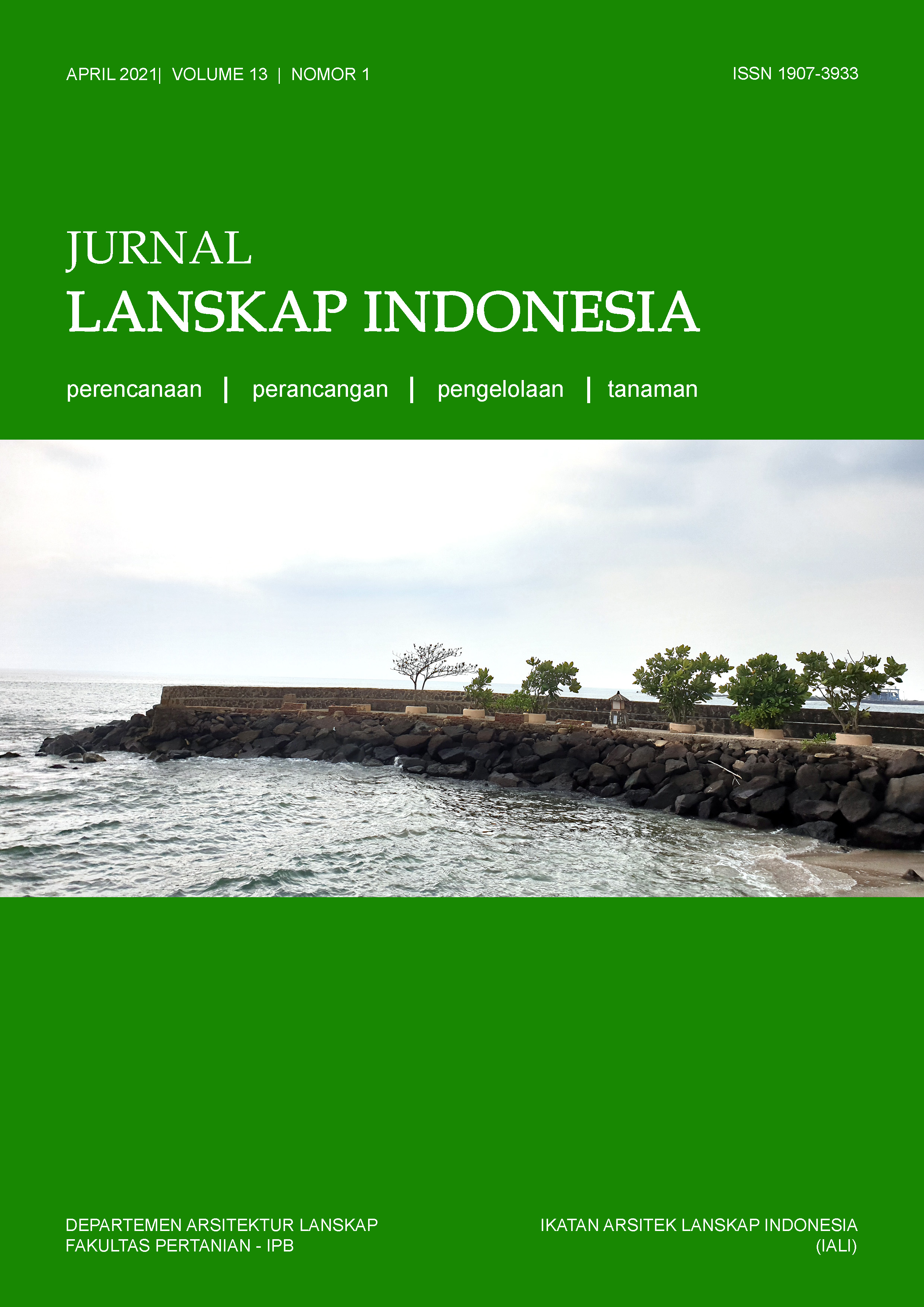Korespondensi Preferensi dan Karakteristik Tipe Wisatawan Grup pada Kawasan Agrowisata
Abstract
Facility planning will be successful if every process always consider the user and activities aspects. This aspects also applies to the agrotourism area, where tourist preference and segmentation can be used to understand visitor desires. This research aims to identify preferences and characteristics of the tourist segmentation in the visited agrotourism areas. This research used a grounded theory approach with qualitative exploratory methods. Data was collected online in an open–ended and close–ended questionnaire which was analyzed in 3 steps; open coding, axial coding, and selective coding. Based on the analysis results, tourists’ preference for visiting agrotourism area were to enjoy natural environment and do various recreational activities. The study also found the tourist characteristics was dominated by visitors who come in groups with close relationship of family and friends. The characteristics of these tourists can be used as a basis of harmonisation for determining the criteria of facilities in agrotourism where the implemented design can give attention to the sustainability (lifecycle) of tourist attraction from natural and economic aspect.
Downloads
References
Assauri, S. 2015. Manajemen Pemasaran Edisi 15. Jakarta: Rajawali Perseda.
Babbie, E. 2007. The Practice of Social Research. United States of Ameriaca: Wadsworth Inc.
Cooper, C., Fletcher, J., Gilber, D., Fyall, A., Wanhill, S. 2005. Tourism Principles and Practice. New Jersey: Pearson Educaion Limited.
Creswell, J.W. 2007. Quantitative enquiry & research design, choosing among five approaches. Book Vol. 2nd ed, data diperoleh melalui situs https://doi.org/10.1016/ j.aenj.2008.02.005. Diakses tanggal 13 Oktober 2020
Dradjat, H.A., Mugnisjah, W.Q. 2017. Pengelolaan Objek Wisata Pertanian Agrowisata Kampoeng Kopi Banaran, PT. Perkebunan Nusantara. Jurnal Lanskap Indonesia, 8(1), 21-26.
Febriana, N.P.R., Kaswanto, R.L.. 2015. Tourism Track Management of Cibeureum Waterfall as a Provider of Landscape Beautification Service at Gunung Gede Pangrango National Park. Procedia Environmental Sciences, 24.
Fitriani, W., Sulistyani, A. 2017. Tipe Pengunjung Air Terjun Tujuh Tingkat di Desa Lubuk Ambacang Kecamatan Hulu Kuantan Kabupaten Kuantan Singingi. JOM FISIP, Vol.4 No.1, 1 – 12.
Ginting, M.S.B., Negara, I.M.K., Sudiarta, I.N. 2015. Analisis Segmentasi Pasar Wisatawan Mancanegara yang Berkunjung ke Bali dari Aspek Sosio-Ekonomi Demografi, Psikografi, dan Perilaku. Jurnal IPTA, Vol.3 No. 2, 98 – 101.
Kotler, P., Armstrong, G. 2006. Principles of Marketing Eleventh Edition. New Jersey: Prentice Hall International Inc.
Nofyanti, N.A., Sidiq, S.S. 2016. Tipologi Pengunjung di Kawasan Wisata Hapanasan Kabupaten Rokan Hulu. JOM FISIP, Vol.3 No.2, 1 – 16.
Pitana, I.G., Gayatri, P.G. 2005. Sosiologi Pariwisata. Yogyakarta: Andi.
Sunaryo, B. 2013. Kebijakan Pembangunan Destinasi Pariwisata Konsep dan Aplikasinya di Indonesia. Yogyakarta: Penerbit Gava Media.
Suprapti, W. 2010. Perilaku Konsumen Pemahaman Dasar dan Aplikasinya Dalam Strategi Pemasaran. Bali: Udayana University Press.
Copyright (c) 2021 Jurnal Lanskap Indonesia

This work is licensed under a Creative Commons Attribution 4.0 International License.
This journal permits and encourages authors to post items submitted to the journal on personal websites or institutional repositories both prior to and after publication, while providing bibliographic details that credit, if applicable, its publication in this journal. However, after the article is submitted and published in this journal, it is fully copyrighted by the Jurnal Lanskap Indonesia or JLI. If excerpts from other copyrighted works are included, the author must obtain written permission from the copyright owner and give credit to the source in the article. Then, the writer or reader is allowed to copy, share, and redistribute articles/material in any form. But it must still include the appropriate source and credit because the article in this journal is licensed by Creative Commons Attribution 4.0 International License (CC BY 4.0).
I. Proposed Policy for Journals That Offer Open Access
Authors who publish with this journal agree to the following terms:
- Authors retain copyright and grant the journal right of first publication with the work simultaneously licensed under a Creative Commons Attribution License that allows others to share the work with an acknowledgement of the work's authorship and initial publication in this journal.
- Authors are able to enter into separate, additional contractual arrangements for the non-exclusive distribution of the journal's published version of the work (e.g., post it to an institutional repository or publish it in a book), with an acknowledgement of its initial publication in this journal.
- Authors are permitted and encouraged to post their work online (e.g., in institutional repositories or on their website) prior to and during the submission process, as it can lead to productive exchanges, as well as earlier and greater citation of published work (See The Effect of Open Access).
II. Proposed Policy for Journals That Offer Delayed Open Access
Authors who publish with this journal agree to the following terms:
- Authors retain copyright and grant the journal right of first publication, with the work after publication simultaneously licensed under a Creative Commons Attribution License that allows others to share the work with an acknowledgement of the work's authorship and initial publication in this journal.
- Authors are able to enter into separate, additional contractual arrangements for the non-exclusive distribution of the journal's published version of the work (e.g., post it to an institutional repository or publish it in a book), with an acknowledgement of its initial publication in this journal.
- Authors are permitted and encouraged to post their work online (e.g., in institutional repositories or on their website) prior to and during the submission process, as it can lead to productive exchanges, as well as earlier and greater citation of published work (See The Effect of Open Access).



























